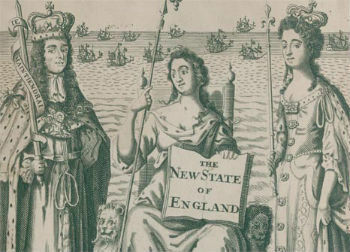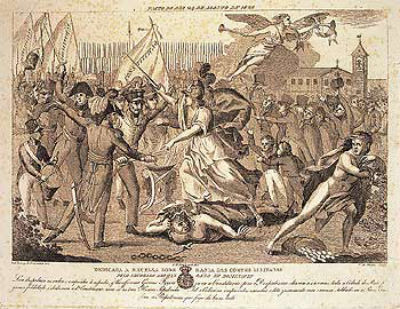You first peoples of america they refer to those who lived in America before the arrival of the European.
They are also called pre-Columbians, as they are located in the period prior to the disembarkation of Christopher Columbus in 1492.
Examples of pre-Columbian peoples are the Incas, Aztecs, Mayans, Guaraníes, Tupinambás, Tupis, Apaches, Shawees, Navajos, Inuit and many others.
Bering Strait
The American continent was already occupied by different peoples about 10 thousand years ago, as shown by archaeological evidence.
The most accepted theory among scientists is that the population of the American continent occurred by crossing the Bering Strait. Chasing the animals, the hunters ended up crossing the strait and settling there.

However, there is evidence pointing to the existence of human beings in this part of the globe, even before incursions across the Bering Strait by alternative routes or by navigation.
Although they were influenced by European colonization, there are peoples who still keep their traditions from their ancestors and pass them on to new generations.
Characteristics of America's First Peoples
The first peoples of America were nomads, hunters and gatherers. According to archaeological studies, its physical characteristics have similar traits to the peoples of Africa, Australia and Mongolian peoples.
This theory is supported by genetic research, which points to a parallel between the DNA of American Indians and the aforementioned peoples.
These people hunted as mastodons, giant sloth, saber tooth tiger and giant armadillo.
Extractivism, however, was not the only way of subsistence for people. Seven thousand years ago, American nations already dominated agriculture and planted squash, potatoes, corn, beans and cassava. Likewise they domesticated small animals.
The American continent was fully populated at the time of the arrival of Christopher Columbus. In addition to collectors, divided into various peoples and spread across the continent, there were civilizations organized in imposing empires, such as the Mayans, Aztecs and Incas.
These civilizations were neither better nor worse than Europeans in many respects, but they had rites and sacrifices that were extremely shocking to Europeans.
Likewise, there were customs in Europe that seemed alien to the natives. The problem was the disproportionate force that was used by the Europeans in invading America, making entire peoples disappear.
Central America
In the region that comprises the Central America – from Mexico to Costa Rica – lived a set of stratified societies, with a complex system of agrarian exploitation and which shared beliefs, technology, art and architecture.
Archaeological estimates indicate that the development of the complexity of these cultures began between 1800 BC. Ç. and 300 a. Ç.
Its technology allowed the construction of temples and the carrying out of research in the areas of astronomy, medicine, writing, plastic arts, engineering, architecture and mathematics.
Cities were important centers of commerce in the region now occupied by Mexico. These civilizations were practically extinct by the colonizing peoples and what was left were historical evidences of their organization and way of life.
Aztecs
You aztecs they lived in the region that today corresponds to Mexico. They were rigidly organized, extremely stratified, with an emperor who was considered a semi-deity and head of the army.
They were a warrior people, who lived their heyday between the 15th and 16th centuries. However, they did not neglect agriculture. Thus, they developed the cultivation of through platforms in order to make the most of the space and arable land.
The Aztec empire was made up of nearly 500 cities in a delicate balance of alliances and rivalries. The navigator Hernán Cortez took advantage of this situation to conquer them.
Mayans

You mayas they lived in the region that today corresponds to Guatemala, Honduras, Belize, El Salvador and the Yucatan Peninsula. They formed a conglomeration of city-states that were constantly at war with each other.
When the settlers arrived, there were at least six million Mayans in the region who were decimated.
They were skilled sculptors and made true works of art in hard materials like jade. They advanced the mathematical calculations and had a calendar with 365 days of the year.
They also built great pyramids, many of which can still be visited today.
They were a polytheistic people and offered human and animal sacrifices to the gods. Just as medieval religiosity encouraged fasting and self-harm, the Maya also included self-sacrifice and offered their own blood to the gods.
South America
THE South America it was populated by several tribes that organized themselves in different ways. We have the Inca civilization that extended following the Andes mountain range, as well as the Mapuches in southern Chile and Argentina.
Likewise, the future Brazilian territory was occupied by dozens of peoples such as the Tupi, the Tamoios, the Aimores, tupiniquins, guaraníes and many others that lost their space as Portuguese colonization progressed.
Incas
You incas inhabited Ecuador, southern Colombia, Peru and Bolivia. At least 700 languages were spoken in the Inca Empire which, like the rest, was conquered and destroyed by the Spaniards.
Although they did not master writing, these people created a counting system, the chipo, and applied it for tax collection. In addition to having developed a method of calculation that used an instrument similar to the abacus.
They considered themselves sons of the sun, were polytheists and had their Inca chief worshiped as a god. Families should give at least one daughter to serve the Inca for a certain period of time.
Indigenous peoples in Brazil

The region that is now occupied by Brazil was inhabited by about 4 million Indians when the Pedro Alvares Cabral landed. Most were made up of gatherers and hunters.
Today, even after the reduction of the indigenous territory, there are 240 indigenous peoples in Brazil who speak up to 150 dialects. The main causes of the population reduction were the colonizing pressure and the diseases brought by the Portuguese.
The remnants of Brazilian indigenous peoples still live in constant dispute for territory and are the target of diseases and live, for the most part, in extreme poverty.
Among these people is the Guarani-caiuá, who live on the border between Mato Grosso do Sul and Paraguay. The murder of indigenous leaders and the occupation of land are constantly reported by the media.
read more:
- Discovery of Brazil
- Guarani Indians
- Indigenous Brazilian Art
- Brazilian Prehistory
North America

The first human settlements in America are registered in present-day Alaska (USA). there, the people inuit occupied areas of Canada and Greenland.
Upon the arrival of the Europeans, the native peoples of North America they were tribes of semi-nomadic behavior as well as hunter-gatherers; and others were sedentary peoples who lived from agricultural activity.
These include the Apache, the Shawee, the Navajo, the Creek, the Cherokee, the Sioux, and many others.
His religiosity was polytheistic with the special cult to the spirit of ancestors and animals. However, in some tribes the theistic cult is registered where there was an entity greater than the others.
In any case, Native Americans had a peculiar worldview where humans, earth mother and sky father are one.
With the west march, indigenous peoples were systematically expelled from their lands. They died on the battlefields, from diseases and also from hunger, because with the occupation of the land the animals were becoming extinct.
The American film industry transformed colonization towards the Pacific as a spectacular event, where Indians were treated in stereotyped and violent ways.
Among the latest events is the massacre of the Sioux in 1890, when the US cavalry executed 150 indigenous people, including men, women and children. The bodies were dumped in a mass grave.
We have more texts on the subject for you:
- discovery of america
- spanish america
- Spanish colonization
- Incas, Mayans and Aztecs


